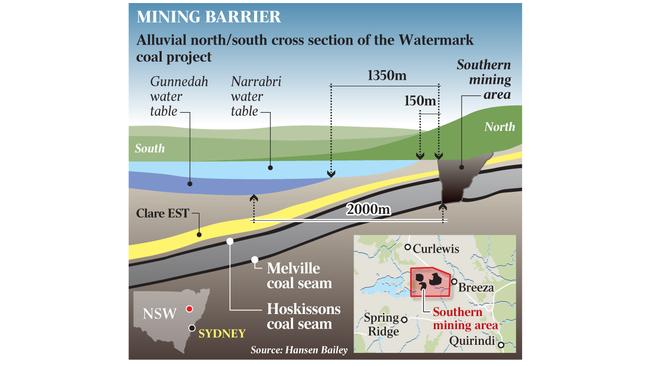Red tape means a decade before Watermark Mine can go ahead
The owners of the Watermark Mine must monitor groundwater impacts for at least 10 years before they can start mining.

The owners of the controversial Watermark Mine must monitor groundwater impacts for at least 10 years before they can start mining the area closest to the fertile black-soil plains and highly productive Gunnedah Formation underground water aquifer.
The delay is one of a string of conditions placed on the project by federal Environment Minister Greg Hunt in an attempt to satisfy concerns of nearby landowners.
As part of its environmental impact statement, mine owner Shenhua said it would maintain a 150m buffer from the open-cut mining areas to the alluvial black soils.
“This buffer prevents the direct connection of water between the Gunnedah Formation aquifer and the mining areas,” according to Shenhua’s EIS.
The independent expert scientific committee on coal-seam gas and large coalmining development told Mr Hunt groundwater modelling predictions were “sufficiently robust to draw conclusions as to the most likely impacts on the Upper Namoi Alluvium, particularly the Gunnedah Formation, at a regional scale”.
The committee said validation of the finer-scale models would only be feasible with observations of the actual responses of the groundwater system to the proposed project.
As a result, under the conditions of its approval by Mr Hunt, mine work cannot begin on the southern mining pit for at least a decade.
“It must first be proven that the groundwater predictions are correct, using over a decade of real information,” according to the conditions.
Mr Hunt has been forced to publicly defend his approval for the Watermark mine from an onslaught of complaints led by Sydney radio broadcaster Alan Jones.
He has agreed to let the independent committee sign off on the water conditions imposed on the project before it is given final approval.
Under the conditions, before the mine can proceed, the federal environment minister must approve a water management plan which will set out rigorous monitoring and reporting requirements to determine the impacts on water and what needs to be done if there are any differences between predicted and actual results.
Jones yesterday continued his attack on the mine approval, claiming it did not make economic or environmental sense.
He was joined by Agriculture Minister Barnaby Joyce, who has maintained his opposition to the project because of its location near prime agricultural land.
Mr Hunt said the mine was not on the black-soil plain and “all the advice is it wouldn’t have any impact on the black-soil plain”.
He said the scientific advice was that the mine would use about one in 1000 parts of the available agricultural water.
“On both the water and the broader question of the land it’s a very different scientific situation and a very different environmental situation to what has been presented in some of the public debates,” Mr Hunt said.
A Shenhua spokesman said the company was confident its management plans, including the water one, could be developed to comply with the strict operating conditions and satisfy the independent committee and the minister.
He said the company had never shied from scrutiny and genuine scientific review of the assessments supporting the Watermark project, which he said had been validated at every stage of the process.
He also outlined that the committee advice “comprehensively” demonstrated that the concerns about groundwater, raised by the farming and irrigation communities, were unfounded.



To join the conversation, please log in. Don't have an account? Register
Join the conversation, you are commenting as Logout